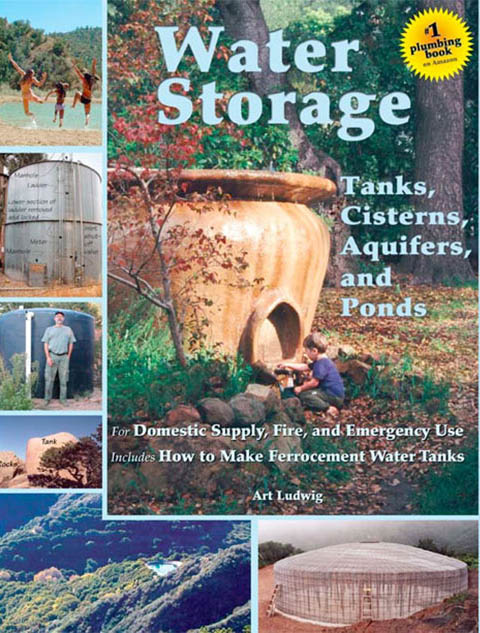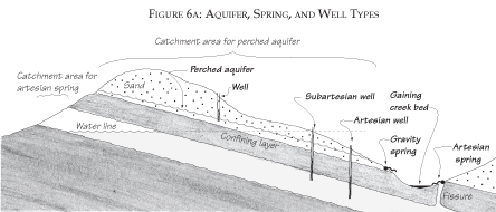Water Storage : Tanks, Cisterns, Aquifers, and Ponds for Domestic Supply, Fire and Emergency Use
Includes How to Make Ferrocement Water Tanks
Book by Art Ludwig
Do-it-yourself guide to designing, building, and maintaining your water tank,
cistern or pond, and sustainably managing groundwater storage. It will
help you with your independent water system, fire protection, and disaster
preparedness, at low cost and using principles of integrated design. Includes
building instructions for several styles of ferrocement water tanks and design details for rainwater harvesting tanks.![]()
On this page:
![]() $19.95 (Bigger image)
$19.95 (Bigger image)
Reviews
Storage that's low cost, low maintenance, high reliability, and high quality...the
keys are right here in your hands. If you run a water system, for a weekend
shack or a whole community, you need this book!
—Doug Pratt, Real Goods Technical Editor
On the average water system, this book will pay for itself a hundred times
over in errors avoided and maintenance savings. Not another stuffy engineering
manual—a very good book that anyone can read. It is especially suited for
operators of small water systems.
—Zane Satterfield, P.E., National Drinking Water Clearinghouse
Practical design solutions, comprehensive illustrations, and plenty of photos—a
thorough treatment of a topic that's vital to our survival.
—Claire Anderson, Home Power Magazine, Mother Earth News
All sorts of alternatives to your standard plastic water tank, accessible by
anyone from homeowner to builder to civil engineer.
—Amy Wynn, Builders Booksource
A comprehensive guide to water systems that explores every facet of designing
and using water resources wisely, efficiently, and in concert with nature. If
you need water, you need this book.
—Richard Freudenberger, Executive Editor, Back Home Magazine
Introduction (Excerpt)
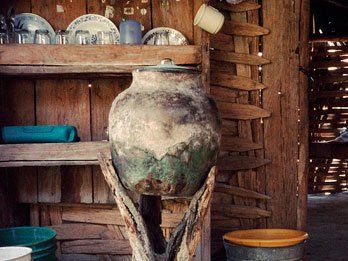 |
| Traditional clay water vessel in Michoacán, Mexico |
Water Storage describes how to store water for home, farm, and small communities. It will help you design storage for just about any use, including fire safety and emergency, in just about any context—urban, rural, or village, in the developing or developed worlds.
This book includes:
- general principles to help you design, construct, and use any water storage system
- a look at common mistakes and how to avoid them
- how the different kinds of storage can serve you—tanks, groundwater, and ponds
- how to determine the optimum amount and location of storage for your needs
- how to determine the best shape and material for your storage
- how to manage aquifers sustainably for inexpensive storage of water in groundwater or the soil sponge
- plumbing details for inlets, outlets, drains, overflows, access, etc.
- storage accessories and gadgets such as automatic shut-off valves, remote level indicators, ozonators, and filters
- how to build your own high-quality tank from ferrocement
- original design innovations—published here for the first time—to improve the quality of stored water, increase water security, make maintenance easier, and reduce environmental impacts
- real-life examples of storage designs for a wide range of contexts
This book offers underlying design principles as well as design specifics. If you run into a situation not specifically covered, there's a good chance you'll be able to use these general principles to figure it out yourself.
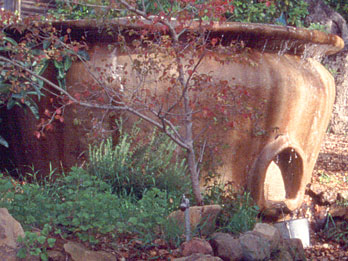 |
| 3500 gallon ferrocement rainwater storage urn |
Installed water storage typically costs fifty cents to three dollars or more a gallon ($60-200/m3). If you've got this book in your hands, you're probably on the verge of making decisions about hundreds or thousands of dollars worth of storage. On an average water system, this book could pay for itself a hundred times over in savings on construction and maintenance.
Most of the information otherwise available on water storage comes from vendors. Oasis Design doesn't sell water storage hardware, so you don't have to worry about being steered towards stuff you don't need. Rather, we make our living by providing accurate information to help people have a higher quality of life with lower impact.
Chapter 1: Thinking About Water (Excerpt)
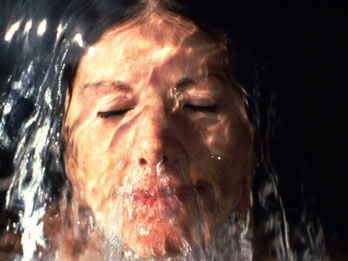 |
To achieve your design goals for a water system, it is helpful to know what your goals are. The first order of business is to consider:
Why Store Water?
Nearly all water systems include some form of storage, most commonly a tank. Storage can be used to:
- cover peaks in demand
- smooth out variations in supply
- provide water security in case of supply interruptions or disaster
- save your home from fire
- meet legal requirements
- improve water quality
- provide thermal storage and freeze protection
- enable a smaller pipe to serve for a distant source
We're going to consider each of these reasons to store water, then look at design principles to help you frame the goals for your project.
Cover Peaks in Demand
The most common function of water storage is to cover short-term use flows that are greater than the flow of the water source. For example, a tiny, one gallon-per-minute spring supplies 1,440 gallons a day. This is several times more than most homes use in a day. However, almost every fixture in the home consumes water at a faster rate than 1 gpm while it is turned on; even a low-flow shower head uses about 1.5 gpm.
By using water stored in a tank, you can supply water to the shower faster than it is flowing from the spring. On completing the shower, the water will be coming in faster than it is going out, and the tank level will rise back up.
If you had a 10,000 gal tank, you could run a 100 gpm fire hose—creating the kind of blast used to bowl over hostile crowds—on the stored water from this tiny spring, for an hour and a half! Hopefully the fire would be out by then, as the tank would take several days to refill.
Short on WaterBy 2025 at least 3.5 billion people—about half the world's population—will live in areas without enough water for agriculture, industry, and human needs... Worldwide, water quality conditions appear to have degraded in almost all regions with intensive agriculture and in large urban and industrial areas. —World Resources Institute, October 2000 |
Smooth Out Variations in Supply
In some circumstances, your storage needs will be affected by variations in the water supply. For instance, if the supply is rainwater, you will need enough storage to make it through the intervals between rainfalls. A six-month, rainless dry season requires a heck of a lot more storage than the most common kind of variable supply—a well pump that cycles on and off.
If you have a well that taps stored groundwater, a tank will save wear and tear on your pump, because the pump won't have to switch on and off every time you open a tap.
Provide Water Security in Case of Supply Interruptions or Disaster
In many places, the water supply chain from source to tap is long and made of many delicate links. If a cow steps on the supply line, a pump breaks, a wire works loose, the electricity goes out, the city misplaces your check, or there is a natural disaster—your water flow could stop. By locating your storage as few chain links away as possible from your use points, a large measure of security is added...
Appendix D: How to Make Ferrocement Tanks (Excerpt)
Ferrocement tanks consist of an armature (framework) of steel reinforcing, which is then covered with a sand-cement plaster. They offer complete flexibility in shape. They have long life, are cost-competitive when contractor-built, and are owner-buildable in both industrialized and non-industrialized countries.
This section describes how to build ferrocement tanks with various techniques, to a variety of standards and sizes from 250-30,000 gal (1-115 m3). With the aid of an engineer you could adapt the plans up to a 100,000 gal (380 m3) tank. For more on the advantages and characteristics of ferrocement tanks, see Tank Materials/ Ferrocement p. 41.
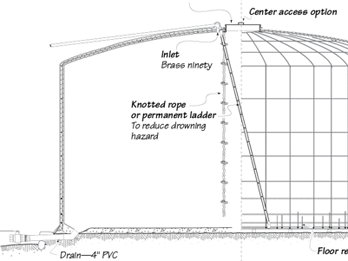 |
| Heavy-duty ferrocement tank (section) |
The existing literature on ferrocement tanks is sparse, and each document is narrowly focused: one particular size of one design, or a variety of designs but all for the context of non-industrialized nations. The heavy-duty ferrocement construction technique described here—which is suitable for large tanks—has not been described in the literature before to my knowledge.
This appendix—practically a book in itself—is unique in that it describes the full range of ferrocement techniques in one place, and reconciles some enormously disparate opinions and techniques into a coherent formulary.
From procedures for ultra-light duty tanks that use the absolute minimum of material, to tanks buildable by native women with no construction experience, to detailed procedures for building large tanks to last a lifetime—you can glean the best approach for your context.
In the do-it-yourself, innovative spirit of ferrocement, this appendix gives you not only recipes but numerous variations and ideas for promising innovations, so that you can follow a recipe or concoct your own to suit:
- Plans for Jumbo Thai Jar, an 800 gal (3 m3) light-duty cistern, which can be adapted to make containers of this shape from 250-800 gal (1-3 m3).
- Description of ultra light-duty ferrocement for cisterns up to 3,000 gal (11 m3) in size in the non-industrialized world.
- Plans for light-duty ferrocement 10,000 gal (38 m3) cistern, adaptable for inexpensive, non-industrialized nation-style cisterns from 500-10,000 gal (1.9-38 m3).
- Construction photos of medium-duty, urn-shaped, ferrocement cistern of 3500 gal (13 m3), which can be used in conjunction with the heavy-duty ferrocement construction plan to guide the construction of medium-duty construction cisterns from 500-15,000 gal (1.9-57 m3). These also illustrate how ferrocement can be used to make creative shapes and details.
- Detailed plans for heavy-duty ferrocement construction of a 30,000 gal (110 m3) cistern, which can be adapted to tanks from 3000-30,000 gal (11-110 m3) capacity, and with the aid of an engineer, tanks up to 100,000 gal (380 m3).
Sample Figures & Photos
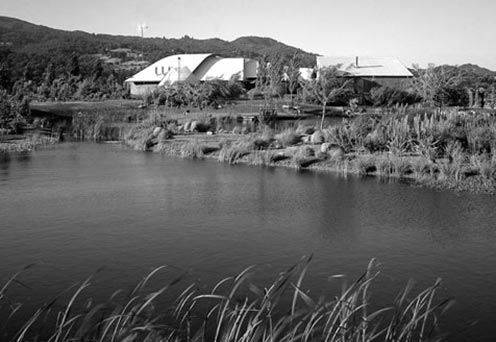
Pond at the Institute for Solar Living
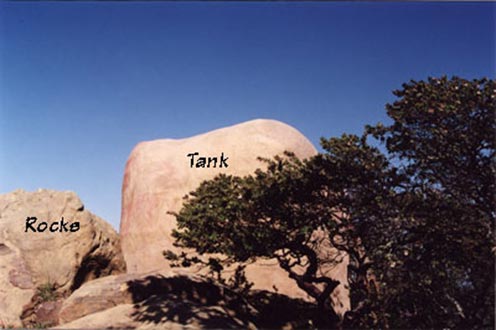
Ferrocement water tank shaped like a boulder
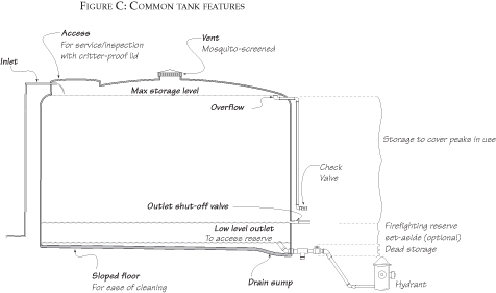
Common features of water tanks
Aquifer, Well, and Spring Types
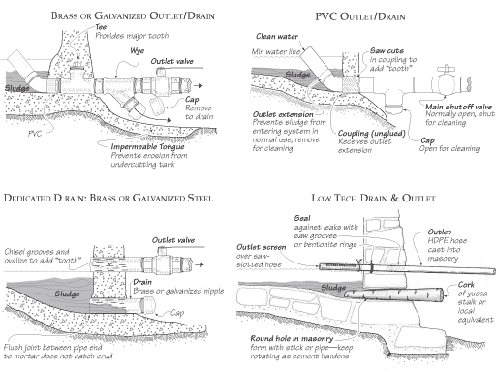
Drain Option Construction Details
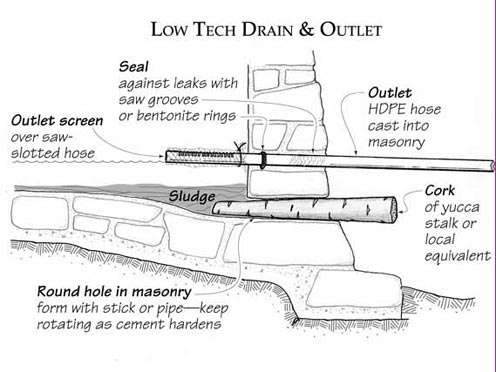
Low tech drain and outlet for mortared stone water tank
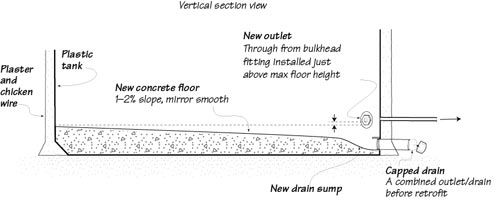
Retrofit of a plastic tank with a sloped floor, sump, and dedicated drain
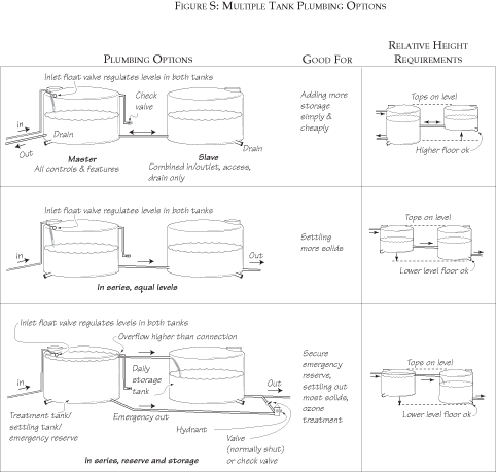
Multiple tank plumbing options
Fire safety
Water for fire safety (PDF 0.5mb)
Contents
Chapter 1: Thinking About Water
Why Store Water?
Cover Peaks in Demand • Smooth Out Variations in Supply • Provide
Water Security in Case of Supply Interruptions or Disaster • Save Your
Home from Fire • Meet Legal Requirements • Improve Water Quality •
Provide Thermal Storage and Freeze Protection • Enable a Smaller Pipe to
Serve for a Distant Source
Design Principles
Water System Design • Performance and Security Standard • Running
Water People, Still Water People • Separate Handling for Different Qualities
of Water • Design Horizon • Design for Failure, Design for Change
• Where the Stuff in Water Ends Up • What Do You Have? What Can You
Find?
How Water Quality Changes in Storage
Ways to Improve Water Quality in Storage • Hazardous Disinfection Byproducts•
Effects of Heating • Bacterial Regrowth • The Problem of Leaching
• Water Age • How to Test Stored Water
Chapter 2: Ways to Store Water
Source Direct (No Storage)
Store Water in Soil
Store Water in Aquifers
How Water Gets into and Moves through Aquifers • How to Increase the
Amount of Water in Your Aquifer • Conjunctive Use • Sustainable management
of groundwater • Overdrafting, Mining Fossil Groundwater • Protecting
Groundwater Quality
Store Water in Ponds
Types of Man-Made Ponds and Where to Put Them • Pond Water Sources •
Evaporation • Pond Size • Pond Depth • Pond Shape • Pond
Inlets and Outlets • Pond Liners • Levee Construction • Wildlife
and Ponds • Sport Fish in Ponds • Pond Maintenance
Store Water in Open Tanks, Swimming Pools
Store Water in Tanks
Chapter 3: Water Tank Design
Tank Components Overview
Situating Water Tanks
Elevation • Stability of Soil and Slope • Aesthetics, Sacred Spots
• Security • Buried Storage
Sizing Water Tanks
Sizing a Tank For Demand Peaks which Exceed Flow • Sizing a Tank When
You Have Limited Water Supply with Scheduled Use • Sizing a Tank to Cover
Use During Interruptions in Supply • Sizing a Tank When Production Is Intermittent
• Sizing a Tank for Firefighting • Size and Structural Integrity
Tank Shape
Tank Materials
Materials Situations to Avoid • Glass • Ferrocement • Galvanized
Steel • Stainless Steel • Porcelain-Bonded Carbon Steel • Brass
• Copper • Aluminum • Rock and Mortar • Concrete •
Brick • Clay • Wood • Plastic • High Density Polyethylene
(HDPE #2) • Ethylene Propylene Diene Monomer (EPDM) • Fiberglass (Glass
Fiber-Reinforced Polyester, GRP) • Epoxy-Coated Steel or Concrete •
Masonry in and over Plastic • Galvanized Steel with Plastic Membrane •
Interior Membranes for Repair • Plastic Bladders • Goat Bladders,
Leather, etc.
Tank Footings and Floors
Tank Roofs
Water-Harvesting Roof
Tank Costs
Really Cheap Storage
Regulatory Requirements
Zoning • Architectural Guidelines • Building Department •
Fire Department • Health Department
Hazards of Stored Water & How to Avoid Them
Drowning • Structural Collapse • Flooding • Pestilence •
Toxic Contamination • Liability Exposure
Water Tanks for Special Applications
Pressure Tanks • Break Pressure Tanks • Hot Water Storage •
Tanks for Transporting Water
Chapter 4: Common Features of Water Tanks
Inlet
Outlet
Service Access
Drain
Tanks with No Drain • Drain Location and Orientation
Overflow
Critter-Proofing
Air Vent
Sunscreen and Shade
Chapter 5: Optional Water Tank Features
Inlet Meter, Filter, Gauges
Inlet Float Valve
Inlet Combined with Outlet
Inlet Aerator
Inlet Diffuser to Improve Settling
Outlet Screen or Filter
Variable Height Outlet
Outlet Float
Water Hammer Air Cushion
Level Indicators
Ozonators
Drain Extension or Baffle
Outlet and Overflow Curves
Pump Controls, Alarms, and Switches
Sand Filter
Multiple Tank Management
Freeze Protection
Chapter 6: Emergency Storage
How Much Emergency Water Do You Need?
Emergency Storage You Already Have
Long-Term Storage in Small Containers
Protecting Stored Water
Systems for Firefighting
Chapter 7: Examples of Storage Systems for Different Contexts
Poor Surface Water Quality, Limited Groundwater
Only Stored Water in Dry Season, Hydroelectric in Wet Season
Creek Direct with Remote Storage and Sand Filtration
Very, Very Low Pressure
Simple Jungle Eden
Rural House with Well
Urban Apartment
Swank Suburban House
Appendix A: Measurements and Conversions
Appendix B: Tank Loads and Structural Considerations
Appendix C: More About Plastics
Appendix D: How to Make Ferrocement Tanks
Ultra-Light Ferrocement over a Form: Jumbo Thai Jar Plans
Ultra-Light-Duty Ferrocement Description
Light-Duty Ferrocement Plans
Medium-Duty Shaped Ferrocement Photos
Heavy-Duty Ferrocement Plans
Tools • Materials • Labor • Design • Site Prep •
Grade for the Floor • Drain • Floor and Inside Wall: Welded Wire Mesh
• Floor and Wall: Rebar • Inlet, Outlet, and Overflow Hardware •
Wall Outer Welded Wire Mesh, First Layer of Lath and Hardware Cloth • Lift
the Whole Thing Up and Get Ready to Pour • Pour the Floor • The Roof,
Cool Shapes, Ladder • Lath and Hardware Cloth • Plaster Prep: Roof
Supports, Seal Door • Plaster the Whole Tank • Keep It Wet •
Color and Seal It • Fill It
Index
- Water testing-download
- Press Release: Water Storage
- Water Storage References
- View Water Storage book index in HTML or PDF.
- Do Rain Barrels Really Work?


